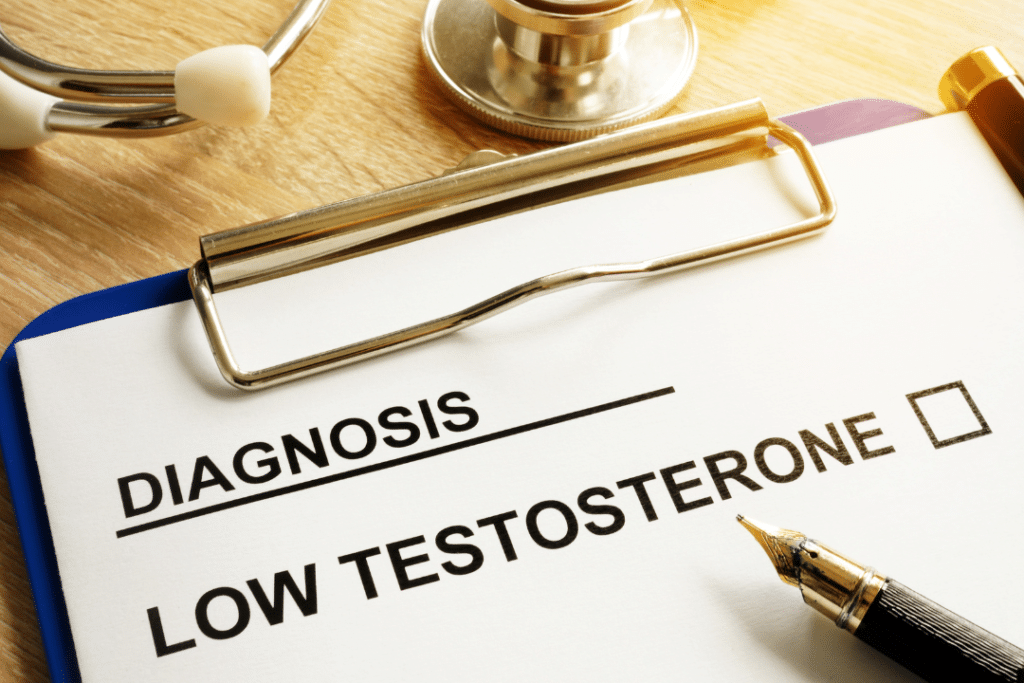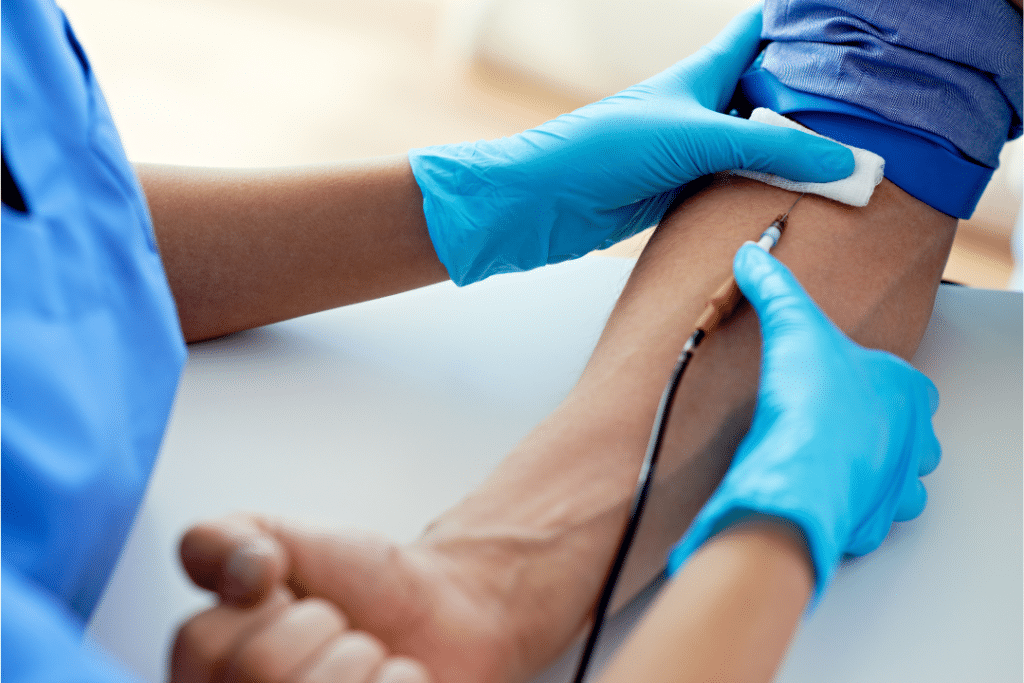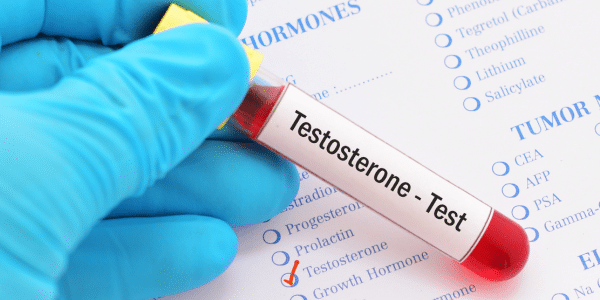Beyond Numbers: Interpreting Your Testosterone Test Results
Are you puzzled by your testosterone test results and unsure what the numbers mean? Let’s face it, interpreting medical reports, especially a test that looks at your testosterone levels, can be tricky.
Sure, many may say, “Leave it to the professionals.” But if you’re like me, you want to be able to look at the results and know what you’re looking at.
This article walks you through understanding your testosterone levels and what they mean for your overall health.
Let’s dive deeper into the topic and demystify these cryptic terms to take charge of your well-being.
Key Takeaways
- A testosterone test measures the levels of testosterone in your body and can provide important insights into various aspects of your health, including mood, sexual function, and muscle mass.
- Reasons to consider getting a testosterone test include physical changes like decreased muscle mass or increased body fat, concerns about sexual health such as reduced libido or difficulties with arousal, and lifestyle factors like exercise, stress management, and diet.
- During a testosterone test, a healthcare professional will draw blood from your vein to measure your hormone levels. It’s important to follow preparation guidelines provided by your healthcare provider for accurate results. Risks involved in the procedure are minimal but can be minimized by going to a reputable facility with trained professionals.
- Interpreting your testosterone test results is crucial for understanding potential health implications. Normal levels range from 300 to 1,000 ng/dL for men and around 20 ng/dL for women. High or low levels may indicate hormonal imbalances or other medical conditions that require further evaluation. Discussing the results with a healthcare professional can help guide appropriate steps for managing hormone balance effectively.

What is a Testosterone Test and What Does it Measure?
A testosterone test is a blood test that measures the levels of testosterone in your body. Typically, testosterone in men will be much higher than that in women. While women will have the hormone testosterone, their estrogen levels tend to be much higher. Testosterone levels are highest in men during puberty and tend to decrease around the age of 30.
While getting your blood drawn at a lab would be the recommended way to test, you can use an at-home testosterone test if you wish. You can easily order this test online if you would like. You then need to send in your sample, and the test details and results will be sent to you.
Some at-home test kits include:
· Everlywell Testosterone Test
· LetsGetChecked Testosterone Test
Disclaimer: For the record, I’m not a doctor, and I’m not prescribing the at-home test, nor am I telling you that you need to go get your testosterone tested. This article is merely for informational purposes only. A simple blood test can tell you if you have low or high levels of the hormone, and the test is usually very quick. If you choose to do an at-home test, you should review the results with your health care provider to understand if your testosterone levels are in the normal range.
Definition of testosterone test
A testosterone test, also known as a hormone blood test, determines the testosterone levels in your body. It predominantly measures two kinds: free and total testosterone. Free testosterone refers to the unbound, readily available hormone, while total testosterone includes both bound and free types.
This test helps shine a light on your hormonal health by measuring how much of this vital hormone is in your bloodstream at any given time. Testosterone plays pivotal roles, particularly in men’s bodies — it affects mood, sexual function, muscle mass, and more! So, seeing these numbers can give you crucial insight into various health aspects.
Purpose of a testosterone test
A testosterone test serves as a vital tool in tracking hormone levels in your body. It gauges the concentration of testosterone in your blood, helping healthcare professionals to evaluate overall wellness and detect potential health issues.
Low or high testosterone counts may indicate conditions such as male hypogonadism or hormonal imbalance.
Detecting abnormal testosterone levels early can influence several aspects of your life, including physical changes and sexual health. For instance, low T levels might cause fatigue, mood swings, or lack of interest in sex, while high testosterone may lead to aggressive behavior or acne.
Therefore, taking a testosterone test offers valuable insight into managing these symptoms effectively.
What a testosterone test measures
The testosterone in the blood meticulously gauges the amount of this crucial hormone in your blood sample. Both your total testosterone level and free testosterone level are measured, providing an accurate summary of how much is available for use by the body. Getting your blood work will consist of a testosterone blood test, total testosterone test, among others.
Notably, healthy men typically exhibit a broad range of 300 to 1,000 ng/dL, while women have about 20 ng/dL. Abnormal results may hint at conditions like male hypogonadism or hormonal imbalances in women, which can greatly impact day-to-day life.
Related Article: Is Your Natural Testosterone Level Low? Here’s How to Fix It
This important test shows not just the numbers but helps understand if you are producing appropriate amounts for optimal health and performance.
Reasons for Taking a Testosterone Test
Testosterone is important in men, not only as a reproductive hormone, but it also plays a vital role in the overall health of men. Getting this type of test done, especially after the age of 30, may be a good idea to check testosterone levels and see what the results mean for your overall health.
It should be noted that testosterone levels vary from person to person. Your levels may still be in the normal range as you age, while others who are the same age may find their testosterone levels decrease.

There are several reasons why someone might consider getting a testosterone test, including symptoms of low testosterone, such as physical changes, sexual health concerns, and lifestyle factors. The test may help pinpoint why you may be feeling a certain way.
Related Article: Testofen — The Solution to Men’s Health and Testosterone?
Many men want to test for low testosterone if they have any of the common signs of low testosterone below:
Physical changes
Physical changes can be one of the reasons why you might consider getting a testosterone test, as the test can help show where your levels are currently. Low testosterone levels can lead to a variety of physical symptoms, such as decreased muscle mass, increased body fat, reduced energy levels, and even changes in hair growth patterns.
On the other hand, high testosterone levels may contribute to excessive muscle growth and aggression. By understanding your testosterone levels through a blood test, you can gain insight into any physical changes that may be related to your hormone balance.
Sexual health concerns
Maintaining a healthy level of testosterone is crucial for sexual health. Low levels of testosterone can impact your libido, leading to decreased sex drive and difficulties with arousal.

In men, it can also contribute to erectile dysfunction. On the other hand, high levels of testosterone may cause an increase in sexual desire but can also lead to aggression or mood swings.
If you’re experiencing any changes in your sexual health or have concerns about your hormone levels, it’s essential to discuss them with a healthcare professional who can help assess your situation and provide appropriate guidance and treatment options.
Lifestyle factors
Maintaining a healthy lifestyle is crucial for optimal testosterone levels. Regular exercise, especially strength training, can help boost testosterone production in the body. Additionally, managing stress levels and getting enough sleep are important factors for hormone balance.
Certain dietary choices, such as consuming adequate amounts of protein and healthy fats, can also support healthy testosterone levels. Finally, avoiding excessive alcohol consumption and cigarette smoking can contribute to maintaining optimal hormonal health.
Related Article: Navigating TRT Costs — Does Insurance Cover TRT Therapy?
By making these positive lifestyle choices, you can support your overall well-being and promote healthy testosterone levels in your body.
What to Expect During a Testosterone Level Test
During a testosterone test, you will have your blood drawn to measure the levels of testosterone in your body. Find out what steps are involved and how to prepare for a testosterone test. Keep reading to learn more about how to prepare for the test and even some risks involved!
Steps of the test
The testosterone test involves a few simple steps. First, a healthcare professional will draw a blood sample from your vein using a needle. This is usually done in the arm. The sample is then sent to a laboratory for analysis.
Once the results are ready, your healthcare provider will explain what they mean and discuss any necessary follow-up steps based on the findings. It’s important to note that this test does not require any special preparation, and it poses minimal risks, such as slight bruising or bleeding at the site of the blood draw.
Preparation required
Before taking a testosterone test, there are a few preparations you may need to consider. First, it’s important to talk to your healthcare provider about any medications you’re currently taking, as some can interfere with the accuracy of the test results.

You may also be advised to fast for hours before the test, usually around 12 hours. This means avoiding food and drinks except for water during that time frame. Lastly, it’s recommended to schedule your testosterone test in the morning, as testosterone levels tend to be highest during this time of day.
By following these preparation steps, you can ensure accurate results from your testosterone test and have meaningful discussions with your healthcare provider about potential interventions or treatments if needed.
Risks involved
It is important to be aware of the potential risks associated with a testosterone test. Although rare, there are some risks involved in the procedure. These include discomfort or pain at the site where blood is drawn, bruising or bleeding, and infection if proper sterilization procedures are not followed.
It’s also possible to experience dizziness or fainting during or after the blood draw. However, these risks can be minimized by ensuring that you go to a reputable healthcare facility with trained professionals who follow strict protocols for blood tests.
Interpreting Your Testosterone Test Results
Understanding your testosterone test results is crucial in determining whether your levels are within the normal range or if there are any potential health implications. It is crucial that you speak with your doctor if you have questions about testosterone.
Understanding the results
Interpreting your testosterone test results is crucial for understanding your hormone levels and potential health implications. Normal testosterone levels for men typically range from 300 to 1,000 ng/dL, while women usually have around 20 ng/dL.
If your results fall outside of these ranges, it could indicate a hormonal imbalance or other medical conditions that need further evaluation. Low testosterone levels can affect physical changes and sexual health, while high levels may lead to aggression or fertility issues.
Reviewing your test results with a healthcare professional who can guide and recommend follow-up steps based on your specific situation is important. Remember, understanding the numbers will help you take proactive steps toward maintaining a healthy balance in your body. In some instances, a doctor may recommend testosterone therapy or testosterone replacement therapy (TRT) as a way to increase your levels back into a normal and healthy range. If you need a testosterone boost, they will prescribe the best forms of testosterone to increase your levels, whether that be an injection or topical gel.
Normal levels vs. high/low levels
When it comes to testosterone levels, it’s crucial to understand the difference between normal, high, and low levels. This helps you make informed decisions about your health and wellness.
| Level | Male Range | Female Range | Implications |
| Normal | 300 to 1,000 ng/dL | around 20 ng/dL | Ensures maintaining secondary sexual characteristics, the production of sperm, and the proper functioning of libido. |
| Low | Less than 300 ng/dL | Not determined | May lead to symptoms like fatigue, depression, decreased libido, and various metabolic issues. If free testosterone levels are below 50-65 pg/mL, it’s considered low. |
| High | More than 1,000 ng/dL | Not determined | Can result in mood disorders, acne, and an increased risk of heart disease. Unusually high levels should be discussed with a healthcare professional. |
Remember, testosterone levels can vary due to genetic factors, physical changes, sexual health concerns, and lifestyle factors. If your levels are outside the normal range, don’t panic. Testosterone levels can be balanced through various treatments, such as hormone replacement therapy. As always, consult with a healthcare professional if you have concerns about your testosterone levels.
Potential health implications
Abnormal testosterone levels can have potential health implications. Low testosterone levels in men, known as male hypogonadism, can lead to symptoms such as decreased libido, fatigue, and mood changes.
Related Article: 5 Ways Testosterone Enhances Health & Well-Being
It may also increase the risk of infertility and osteoporosis. On the other hand, high testosterone levels can cause acne, aggression, and an increased risk of heart disease. It’s important to discuss your test results with a healthcare professional who can provide guidance on further steps or treatments if necessary.
Follow-up steps
After receiving your testosterone test results, there are several follow-up steps you can take to ensure that you are proactive in managing your hormone levels:
- Schedule a follow-up appointment with your healthcare provider: Discussing your test results with a healthcare professional can help you gain a better understanding of what the numbers mean for your overall health.
- Consider further testing: Depending on your results and any symptoms you may be experiencing, your doctor might recommend additional tests to assess other possible underlying causes or conditions.
- Explore treatment options: If your testosterone levels are outside the normal range, your doctor may propose various treatment options, such as hormone replacement therapy (HRT) or lifestyle modifications to help balance your hormones.
- Take steps towards a healthy lifestyle: Maintaining a healthy diet and engaging in regular exercise can also contribute to optimized testosterone levels. Talk to your doctor about any changes you can make to support hormone balance naturally.
- Monitor changes and be proactive about symptoms: Keep track of any changes in your body or mood and communicate them promptly to your healthcare provider. This information will help guide ongoing management of your testosterone levels.
Do You Need to Get a Testosterone Test?
Understanding and interpreting your testosterone test results is crucial for assessing your overall health and well-being. By knowing what the numbers mean and how they relate to your symptoms, you can take appropriate steps to address any potential issues.
Related Article: HRT vs. TRT — Decoding the Hormonal Puzzle for Your Health
Whether it’s seeking medical advice or exploring treatment options, being proactive about managing your testosterone levels can lead to improved physical and sexual health. Don’t let the numbers be just numbers; use them as a guide towards optimizing your hormone balance for a better quality of life.
FAQs
A testosterone blood work test measures the total amount of testosterone in the body, helping to identify high or low testosterone levels.
It’s important because low testosterone can affect your health and wellness. Signs of abnormal testosterone levels could indicate underlying medical problems.
Yes, you can use an at-home testosterone level test for initial assessment before reaching out for professional help if signs of low or high Testosterone are present.
If your total T levels show as either too high or too low on the results from your at-home testosterone test, consult with a healthcare provider immediately for further testing and interpretation.
As men age, their natural testosterone decreases (typically starting around the age of 30); thus, frequent checks become more critical, especially when showing symptoms associated with lowered rates like fatigue or mood changes.


*Disclosure: This article may contain affiliate links or ads, which means we earn a small commission at no extra cost to you if you make a purchase through these links. These commissions help support the operation and maintenance of our website, allowing us to continue producing free valuable content. Your support is genuinely appreciated, whether you choose to use our links or not. Thank you for being a part of our community and enjoying our content.
PLEASE CONSIDER SHARING THIS ON YOUR SOCIAL MEDIA TO HELP OTHERS LEARN MORE ABOUT THIS TOPIC.





